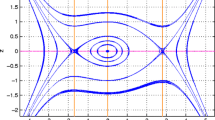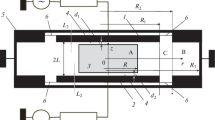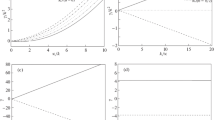Abstract
The aim of this analytical study of a plasma-filled rectangular cavity in time domain is to exhibit the ability of the evolutionary approach to study the electromagnetic fields forced by surge signals in a dynamical system. Maxwell’s equations for the fields and the boundary conditions for the perfect electric conductor rectangular cavity are supplemented with the constitutive relation for the plasma. Two different pulse waveforms were used for modeling of the surge signals exciting the fields. The solution is obtained for the dynamical system in the form of product of two elements. First element that depends on coordinates is a modal basis. The other element depending on time is a modal amplitude. The modal basis is specified as a summation of four subspaces. Two of these subspaces resemble the solenoidal modes, and the other two resemble the irrotational modes. Evolutionary differential equations with initial conditions are obtained and solved analytically for the amplitudes.
Similar content being viewed by others
References
P. Hillion, “Some Comments on Electromagnetic Signals,” in Essays on the Formal Aspects of Electromagnetic Theory. Ed. by A. Lakhtakia (World Scientific, Singapore, 1993), pp. 127–137.
H. F. Harmuth, “Electromagnetic Transients Not Explained by Maxwell’s Equations,” in Essays on the Formal Aspects of Electromagnetic Theory. Ed. by A. Lakhtakia (World Scientific, Singapore, 1993), pp. 87–126.
P. Bernekorn, A. Karlsson, and G. Kristensson, “Propagation of Transient Electromagnetic Waves in Inhomogeneous and Dispersive Waveguides,” J. Electr. Waves Appl. 10, 1263 (1996).
S. L. Dvorak and D. G. Duldy, “Propagation of Ultra-Wide-Band Electromagnetic Pulses through Dispersive Media,” IEEE Trans. Electromagn. Comp. 37(2), 192 (1995).
G. Kristensson, “Transient Electromagnetic Wave Propagation in Waveguides,” J. Electr. Waves Appl. 9, 645 (1995).
O. A. Tretyakov and F. Erden, “Evolutionary Approach to Electromagnetics As an Alternative to the Time-Harmonic Field Method,” IEEE APS/URSI Meeting (2012) [doi. org/10. 13140/2. 1. 2283. 4242].
M. Camp and H. Garbe, “Susceptibility of Personal Computer Systems to Electromagnetic Pulses with Double Exponential Character,” Adv. Radio Sci. 2, 63 (2004).
J. M. Cramer, R. A. Scholtz, and M. Z. Win, “On the Analysis ofUWBCommunication Channels,” in Proceedings of the IEEE Military Communications Conference. Vol. 2, pp. 1191–1195 (1999) [DOI: 10. 1109/MILCOM. 1999. 821392].
F. Erden and O. A. Tretyakov, “Excitation by a Transient Signal of the Real-Valued Electromagnetic Fields in a Cavity,” Phys. Rev. E. 77, 056605 (2008).
O. A. Tretyakov and F. Erden, “Temporal Cavity Oscillations Caused by a Wide-Band Double-Exponential Waveform,” in Proceedings of the 4th International Workshop on Electromagnetic Wave Scattering (September 18–22, 2006, Gebze, Kocaeli, Turkey) [DOI: 10. 13140/2. 1. 4591. 6165].
O. A. Tretyakov and F. Erden, “Temporal Cavity Oscillations Caused by a Wide-Band Waveform,” Prog. Electromagn. Res. B. 6, 183 (2008).
R. N. El-Sharif and Kh. H. El-Shorbagy, “Inhomogeneous Relativistic Electron Beam Interaction with Inhomogeneous Warm Plasma,” Phys. Wave Phenom. 21(3), 222 (2013) [DOI: 10. 3103/S1541308X13030084].
M. Camp and H. Garbe, “Parameter Estimation of Double Exponential Pulses (EMP, UWB) with Least Squares and Nelder–Mead Algorithm,” IEEE Trans. Electromagn. Comp. 46, 675 (2004).
G. Wu, “Shape Properties of Pulses Described by Double Exponential Function and Its Modified Forms,” IEEE Trans. Electromagn. Comp. 56, 923 (2014).
M. S. Antyufeyeva and O. A. Tretyakov, “Pulse Excitation of a Cavity with Dispersive Medium That Refractive Index is Positive and Negative,” in Proceedings of the 5th International Conference on Ultrawideband and Ultrashort Impulse Signals (September 6–10, 2010, Sevastopol), pp. 134–135 [DOI: 10. 1109/UWBUSIS. 2010. 5609163].
A. Torre, “Relativistic Laguerre Polynomials and Splash Pulses,” Prog. Electromagn. Res. B. 13, 329 (2009).
O. A. Tretyakov, “Essentials of Nonstationary and Nonlinear Electromagnetic Field Theory,” in Analytical and Numerical Methods in Electromagnetic Wave Theory. Ed. by M. Hashimoto, M. Idemen, and O. A. Tretyakov (Science House Co. Ltd., Japan, 1993), pp. 123–146.
S. Aksoy and O. A. Tretyakov, “Study of a Time Variant Cavity System,” J. Electromagn. Waves Appl. 16, 1535 (2002).
S. Aksoy and O. A. Tretyakov, “The Evolution Equations in Study of the Cavity Oscillations Excited by a Digital Signal,” IEEE Trans. Antennas Propagat. 52(1), 263 (2004) [DOI: 10. 1109/TAP. 2003. 822399].
F. Erden and O. A. Tretyakov, “Temporal Evolution of the Irrotational and Solenoidal Cavity Modes,” in Proceedings of the 30th URSI General Assembly and Scientific Symposium (August 13–20, 2011, Istanbul, Turkey), pp. 1–4 [DOI: 10. 1109/URSIGASS. 2011. 6050488].
F. Erden and O. A. Tretyakov, “Analytical Approach for Studying a Time-Domain Cavity Problem,” in IEEE International Symposium on Antennas and Propagation and USNC-URSI National Radio Science Meeting (July 6–11, 2014, Memphis, TN, USA), pp. 131–132 [DOI: 10. 1109/APS. 2014. 6904397].
F. Erden, “Evolutionary Approach to Solve an Novel Time-Domain Cavity Problem,” IEEE Trans. Antennas Propag. 65(11), 5918 (2017) [DOI: 10. 1109/TAP. 2017. 2752240].
S. Aksoy, M. Antyufeyeva, E. Basaran, A. A. Ergin, and O. A. Tretyakov, “Time-Domain Cavity Oscillations Supported by a Temporally Dispersive Dielectric,” IEEE Trans. Microwave Theory Techn. 53, 2465 (2005).
G. Gradoni and L. R. Arnaut, “Transient Evolution of Eigenmodes in Dynamic Cavities and Time-Varying Media,” Radio Sci. 50, 1256 (2015).
A. E. Dubinov and M. A. Sazonkin, “Supernonlinear Ion-Acoustic Waves in a Dusty Plasma,” Phys. Wave Phenom. 21(2), 118 (2013) [DOI: 10. 3103/S1541308X13020039].
E. J. Rothwell and M. J. Cloud, Electromagnetics (CRC Press, Boca Raton Florida, 2001).
J. VanBladel, Electromagnetic Fields (Hemisphere Publ., N. Y., 1985).
R. E. Collin, Field Theory of Guided Waves, 2nd ed. (Wiley–IEEE Press, N. Y., 1990).
J. A. Lappo-Danilevsky, Theory of Functions onMatrices and Systems of Linear Differential Equations (ONTI State Tech.-Theor. Press, Leningrad, 1934) [in Russian].
S. Hayashi, Surges on Transmission Systems (Denki-Shoin Inc., Kyoto, Japan, 1955).
Author information
Authors and Affiliations
Corresponding author
About this article
Cite this article
Erden, F. Study of the Surge Signals in a Plasma-Filled Rectangular Cavity. Phys. Wave Phen. 26, 139–149 (2018). https://doi.org/10.3103/S1541308X18020085
Received:
Published:
Issue Date:
DOI: https://doi.org/10.3103/S1541308X18020085




